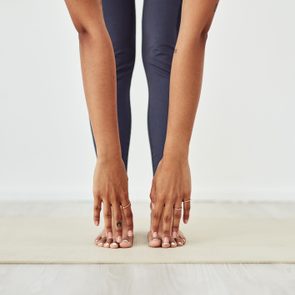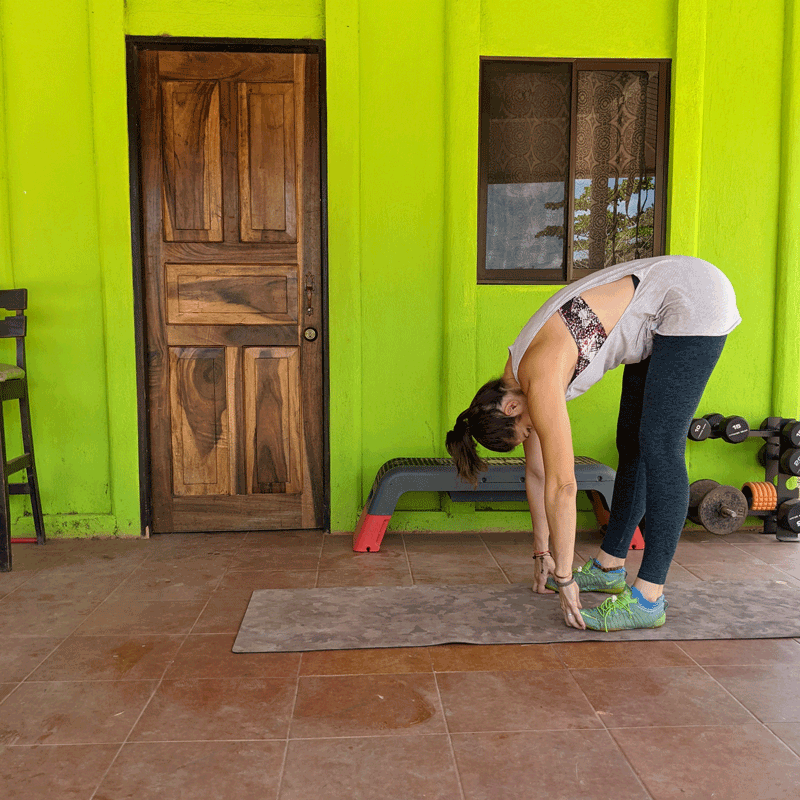Get More Flexible With This 10-Minute, Full-Body Stretch Routine
Updated: Jun. 04, 2021
This full-body stretch routine can be done dynamically or statically for a warm-up before a workout or to increase flexibility post workout.
Making time to stretch
Even if you struggle to slow down, relax, and really stretch out, you know you always feel better when you do. There’s just something about a nice, long stretching session that eases tension and clears your head.
That said, it’s not unusual for stretching to get pushed aside in favor of “real workouts” like cardio and strength training, especially if you’re always feeling pressed for time.
We hear you: life is busy. But mobility training (which comes in many shapes and sizes) is incredibly important for long-term health and wellness.
Reasons to stretch
Stop asking yourself whether you should stretch. The answer is a big, fat yes.
The better question: why does stretching matter so much? Well, it has to do with both your body and mind.
Maintain joint mobility
“It’s important to incorporate stretching into a healthy-living routine to keep your joints healthy,” says Daniel DeLucchi, a Seattle-based chiropractor.
Sit behind a desk all day, every day, and your range of motion becomes limited. When we move beyond this limited range of motion, we can injure ourselves.
“Countering these lifestyle-created limitations through regular stretching widens your body’s ability to perform and maintain your regular movement patterns and healthy habits,” DeLucchi says.
But maintaining your joints’ range of motion and enjoying proper mobility aren’t the only reasons to stretch.
Better mental health
“Stretching can be a great way to incorporate breathing and mindfulness into your daily routine, inhibiting the sympathetic nervous system and allowing you to relax,” says Jake Harcoff, MS, a certified strength and conditioning specialist and the head coach and owner of AIM Athletic in British Columbia, Canada.
In a world where chronic stress can play a major role in negative health outcomes, stretching for even 10 minutes daily can pay off when it comes to reducing anxiety and giving you space to breathe.
Prevent injury
Done correctly, stretching is an excellent way to prepare your body for the rigors of a workout. And it can help you prevent injury.
“Dynamic stretches warm up the muscle groups that you’re going to be using for the activity you plan on doing, while static stretching is used post exercise to increase flexibility,” says Ashley Hunt, a certified corrective and orthopedic exercise specialist and the founder of Pancea, an integrative health app for chronic pain.
Both forms of stretching are important. With proper use, they can help you make the most of all of the physical activity you’re engaging in, whether it’s lifting weights, running, or playing sports.
How to add a full-body stretch routine
When you’re considering adding a stretching routine to your daily life, you need to think about when you plan to do it, whether it’ll be part of a longer workout, and how you’re going to complete each stretch.
Once you know those details, you can determine whether static vs. dynamic stretching is better for your routine.
Static stretches
These stretches are your “traditional” stretches. Doing a static stretch, you’ll move to the end of your personal range of motion, then hold the position.
These are best performed at the end of a workout, when your body is nice and warm. Alternately, they can be performed as tension-relieving “comfort” stretches when you’re feeling tight or stressed.
Generally speaking, you should hold each stretch for 20 to 30 seconds, repeating the stretch two to three times for a total of a minute.
Choosing eight to 10 stretches that hit all of your major muscle groups can make an excellent static stretching routine.
Dynamic stretches
Dynamic stretches are typically performed before a workout as part of a warm-up. They’re designed to prepare your body for the type of work you’ll do during your workout.
When done correctly—moving to the end of your natural range of motion and back out of it again in a steady, controlled manner—they can help reduce the likelihood of injuries during your workout routine.
For any given stretch or movement pattern, the goal is to perform the movement roughly 10 times in succession.
You can string these movements together, choosing between five and 10 different movements, to create a full-body stretch routine.
Cycling through the entire routine two times makes for an excellent dynamic stretch.
Modifying stretches
Most static stretches can be performed dynamically by simply moving to the end of your range of motion, pausing, then moving out of the stretch.
You can also consider ways to modify stretches to make them more static or dynamic.
“An example of a static stretch would be holding your arms out to the side as wide as you can, then holding the position to stretch your chest,” says Delucchi.
Now modify it to be a dynamic stretch: “Bring your arms out to the sides and create big circles with movement. This targets more muscle groups and is good as a warm-up,” he says.
If you’re performing a stretch routine on a recovery day when you don’t plan on performing another workout, you can combine static and dynamic stretches into a single routine.
Simply perform your stretches dynamically for one or two sets, helping warm up your joints and muscles, then for your final one or two sets, perform each stretch statically, holding the stretches in place.
(These are the types of stretching fitness experts recommend.)
A 10-minute full-body stretch routine
This full-body routine consists of stretches suggested by DeLucchi, Harcoff, and Hunt. It’s the perfect option for hitting every major muscle group.
It should take about 10 minutes to perform and can be done as a dynamic or a static stretching routine.
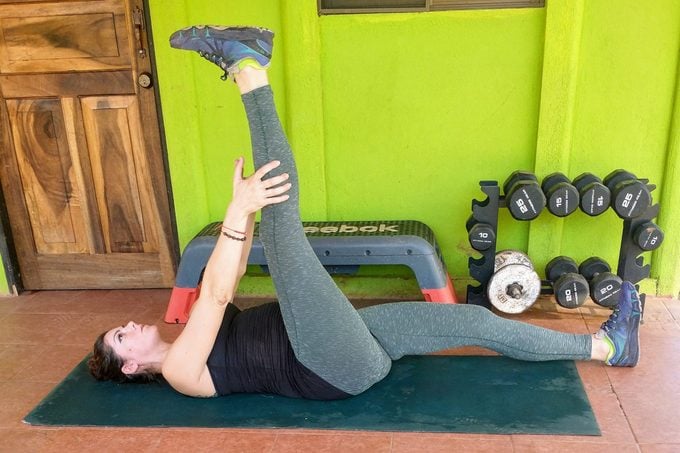
Lying Hamstring Stretch
Lie on your back on a mat, your legs fully extended. A slight bend in your knee is OK if your hamstrings are particularly tight.
Lift your right leg as high as you can, bringing it toward your torso.
Use both hands to lightly grasp behind your right leg, right above or below your knee, depending on what feels comfortable. Pull your leg closer until you feel a light stretch in your right hamstring.
Static stretch
Hold the position for 20 to 30 seconds before releasing and repeating on the opposite side.
Dynamic stretch
Bring your leg to the point where you feel a good stretch, then lower your leg again, fully controlling the movement.
Repeat 10 to 15 times with one leg before repeating on the opposite side.
(Add these hamstring exercises to your workout.)
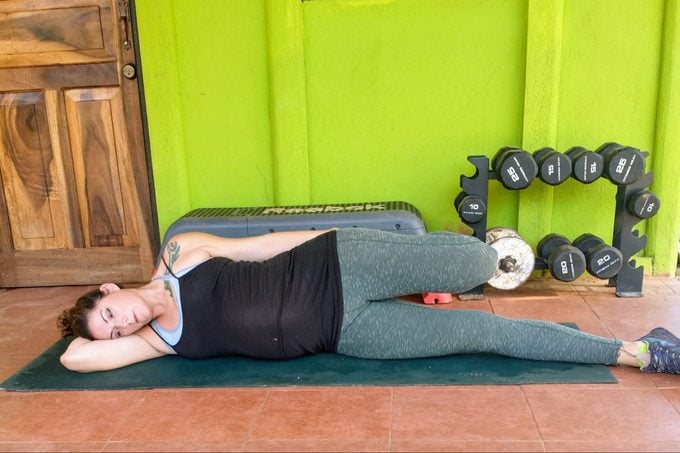
Side-Lying Quad Stretch
Lie on your right side on a mat, using your right forearm to support your head and neck while keeping your spine in alignment.
Bend your left knee and draw your left heel toward your butt.
Use your left hand to grasp your ankle and draw your heel closer to your butt until you feel a stretch through the front of your left thigh.
Hold the position for 20 to 30 seconds then switch sides.
Dynamic stretch
To make this a dynamic stretch, draw your ankle to your butt until you feel a stretch. Release your leg, keeping your ankle flexed, as though you were performing a “glute kick.”
Continue for 10 to 15 repetitions before switching sides.
(Loosen up your legs with these quad stretches.)
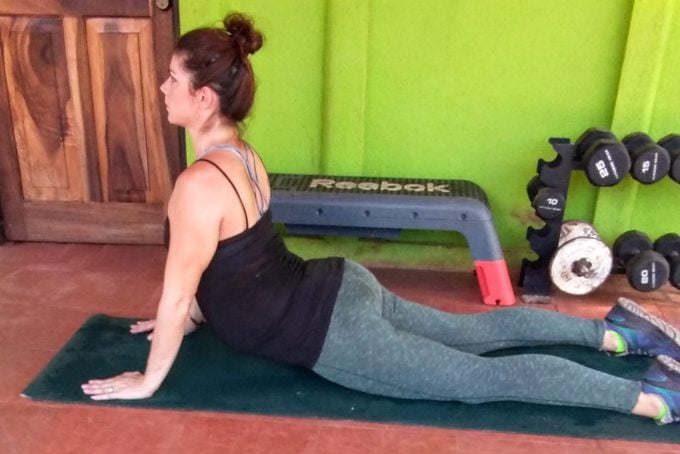
Cobra Stretch
Lie on your belly on a mat, your legs extended, your palms flat on the ground under your shoulders.
Take a breath in and lift your chest and shoulders from the mat, drawing your shoulders back until you feel a stretch through your chest and shoulders and a nice extension through your upper back and neck.
Lightly support the stretch with your hands. If you can, continue lifting your torso from the mat as you extend your elbows and continue stretching through your abdominals.
Stop when you feel a good stretch and hold for 20 to 30 seconds.
Dynamic stretch
To make the stretch more dynamic, lift your chest and torso until you feel a good stretch, hold for a beat, then release your torso back to the starting position.
Repeat 10 to 15 times.
(Learn more about doing a cobra stretch for back flexibility.)
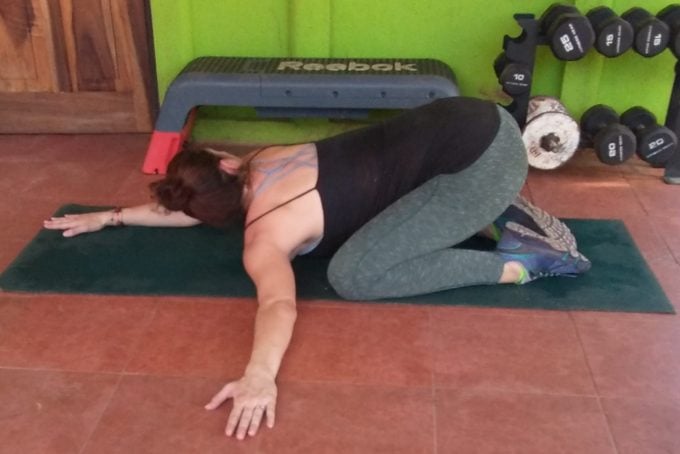
Child’s Pose With Chest Opener
Kneel on the mat on all fours. Position your hands under your shoulders, your knees under your hips, and your heels together.
Sit your hips back on your heels and extend your arms forward and overhead, allowing your belly to sink between your knees.
You should feel a stretch through your spine, upper back, the back of your shoulders, and even your biceps.
Static stretch
Hold the position for 20 to 30 seconds.
From this position, extend your left arm out to the left of your body, as though forming half of a T.
Turn your head to the right and twist your shoulders and chest slightly to the right until you feel a good stretch through the front of your left shoulder.
Hold for 20 to 30 seconds before returning to child’s pose. Repeat the same stretch, this time turning to the opposite side.
Dynamic stretch
To make the stretch more dynamic, move smoothly from child’s pose to the left-sided stretch and then the right sided stretch. Your movement will be fluid until you’ve performed the stretch on each side 10 to 15 times.
(Improve your posture with these chest stretches.)
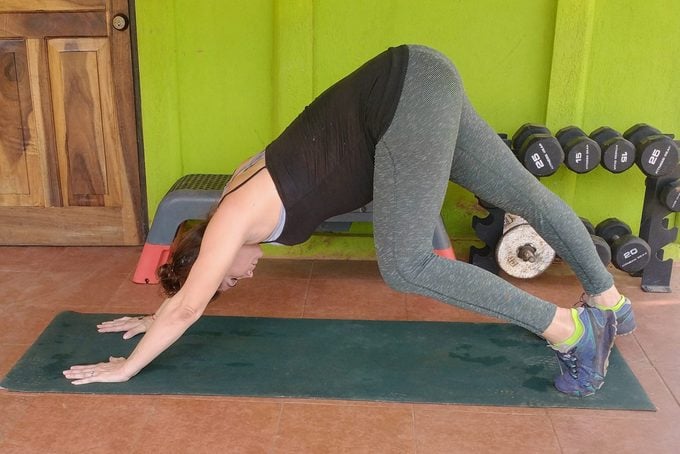
Downward Dog With Walkout
Come to a high plank position on your mat. (It’s the same position you’d be in if you were at the top of a push-up.) Your palms should be under your shoulders, your legs fully extended, and your toes tucked.
Press your hips up toward the ceiling as you extend your arms up from your shoulders to form an inverted V.
Press your heels toward the ground. They don’t need to touch the ground, however.
You should feel a stretch through your calves, hamstrings, chest, shoulders, and glutes.
Hold the position for 20 seconds.
Bend your right knee, pressing your left heel closer to the ground to deepen the calf stretch. After 20 seconds, switch sides.
Dynamic stretch
After coming to the downward dog position (the inverted V), “pedal” your legs out slowly, bending and extending one knee, then the other, until you’ve pedaled 10 to 15 times per leg.
(Limber up with yoga’s sun salutation sequence.)
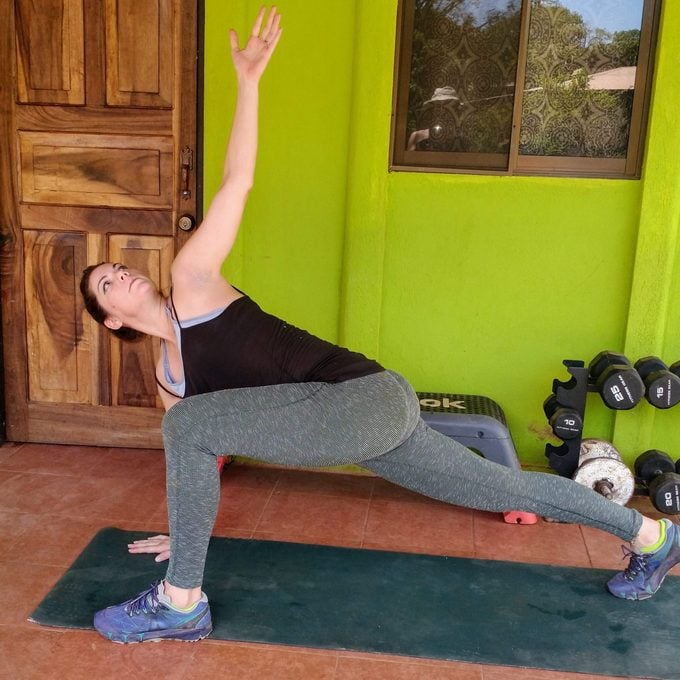
World’s Greatest Stretch
Come to a high plank position on your mat. Position your palms under your shoulders, fully extend your legs, and keep your core tight and engaged.
Step your left foot forward, placing it to the outside of your left hand in a deep lunge. You should feel a stretch through your glutes, hips, and calves.
From here, reach your left arm up toward the ceiling, twisting your torso to your left side and looking up as you perform the reach. This will stretch your chest and shoulders.
Static stretch
Hold this position for 20 to 30 seconds before releasing.
Return to high plank, then repeat the stretch on the opposite side.
Dynamic stretch
After reaching your left arm up toward the ceiling, hold for a beat. Return to high plank and repeat the lunge and reach on the opposite side.
Continue moving back and forth, alternating sides until you’ve completed 10 to 15 repetitions per side.
(Ease hip pain with these stretches.)
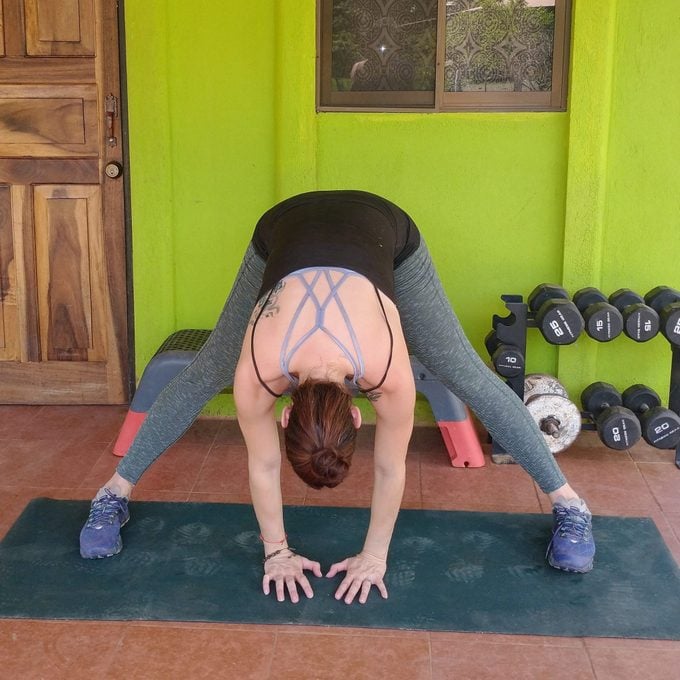
Wide-Legged Forward Fold
Stand tall on your mat with your feet hip-distance apart, your core engaged, and your posture strong.
Walk your feet out to the sides, using a heel-toe movement, until you feel a stretch through your inner thighs and groin.
From here, tip forward from your hips, keeping your core engaged to control the movement. Slowly release your chest and shoulders toward the mat until you feel a good stretch through your hamstrings.
If you can, allow your fingers to rest on the mat.
Static stretch
Hang loose, releasing tension through your upper back, shoulders, and neck, for 20 to 30 seconds.
Dynamic stretch
Keep your back straight and flat as you lower your chest toward the floor, pressing your hips back as you go.
When you feel a light stretch in your hamstrings, reverse the movement and lift your chest back as you return to standing. This should be a very steady and controlled movement.
Perform the action 10 to 15 times.
(These groin stretches will improve flexibility in your adductor muscles.)
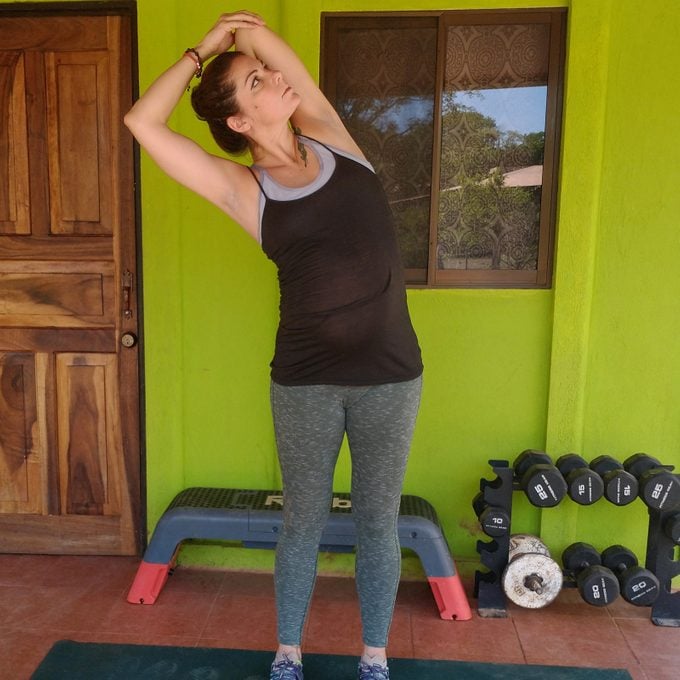
Triceps Stretch With Side Bend
Stand on your mat with your feet hip distance apart. Check your posture. Your ears should be stacked above your shoulders, hips, knees, and ankles.
Engage your core, then extend your right arm directly overhead before bending your right elbow and dropping your right hand straight down your back. Your palm will touch between your shoulder blades.
Extend your left arm overhead, bend your elbow, and grasp your right arm (just above the right elbow) with your left hand.
Use your left hand to pull lightly on your right arm, reaching your right hand further down your spine until you feel a stretch in your right triceps.
From here, keeping your hips steady, lean slightly to the left stretching out your right side as you stretch your triceps.
Static stretch
When you feel a good stretch, hold the position for 20 to 30 seconds. Then switch sides.
Dynamic stretch
After feeling a good stretch through your right side, take a breath, return to standing, then repeat until you’ve completed 10 to 15 reps.
Repeat on the opposite side.
Next, give these other triceps stretches a try.



















